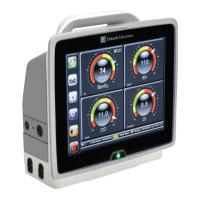6
88
User Interface Settings
Contents
Patient Data . . . . . . . . . . . . . . . . . . . . . . . . . . . . . . . . . . . . . . . . . . . . . . . . . . . . . . . . . . . . . . . . . . . . . . . . . .88
Monitor Settings . . . . . . . . . . . . . . . . . . . . . . . . . . . . . . . . . . . . . . . . . . . . . . . . . . . . . . . . . . . . . . . . . . . . . . .91
6.1 Patient Data
After the system is turned on, the user has the option to either continue monitoring the last patient or to
start monitoring a new patient. See figure 6-1 below.
NOTE If data for the last patient monitored is 12 hours or older, the only option is to start a
new patient.
6.1.1 New Patient
Starting a new patient clears all previous patient data. The alarm limits and continuous parameters are set to
their default values.
WARNING Upon initiation of a new patient session, the default high/low physiological alarm
ranges should be checked to ensure that they are appropriate for the given patient.
Figure 6-1 New or continuing patient screen
Status = Released Printed Date: 2018-01-16 Released Date: 2017-09-14

